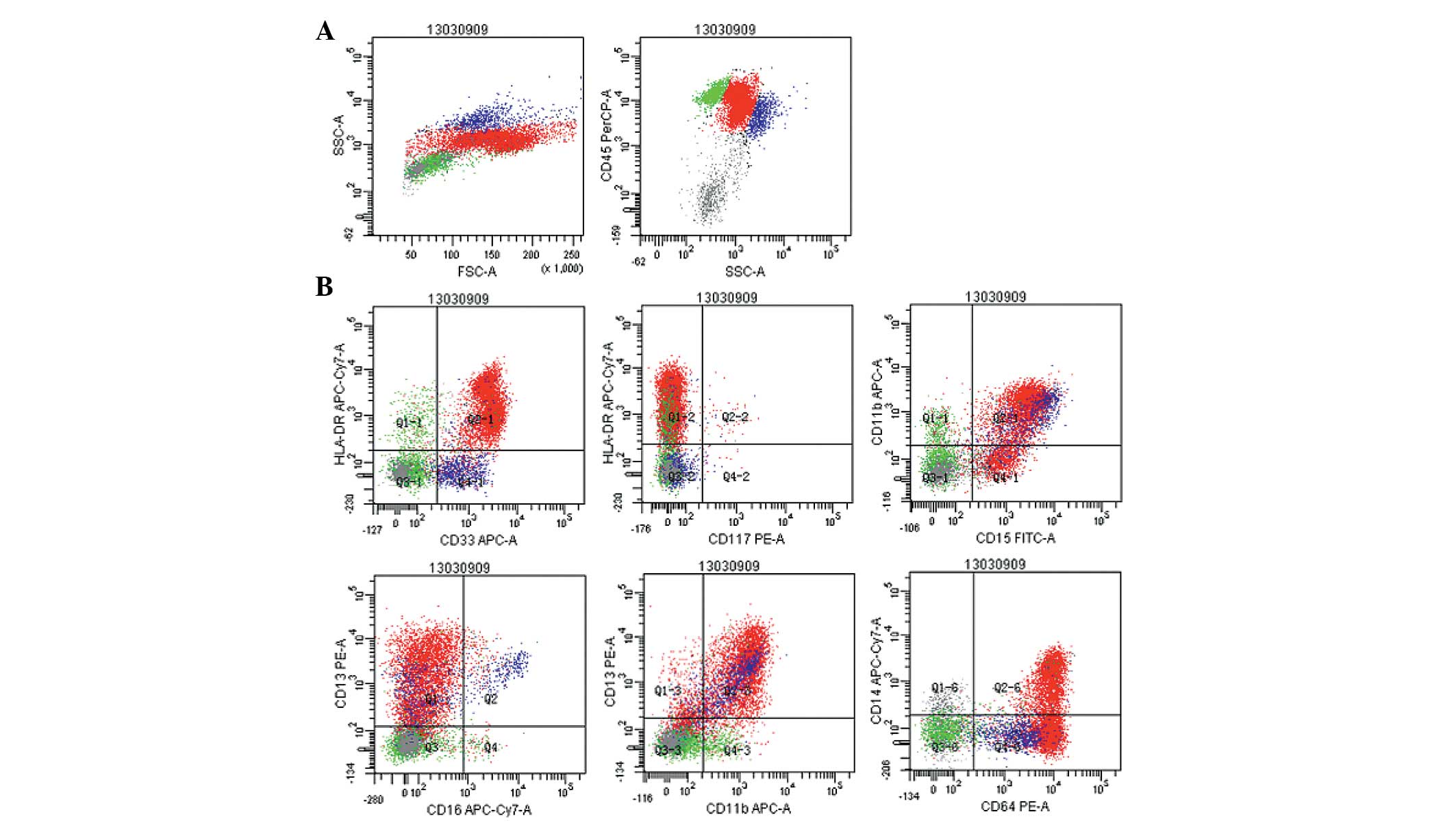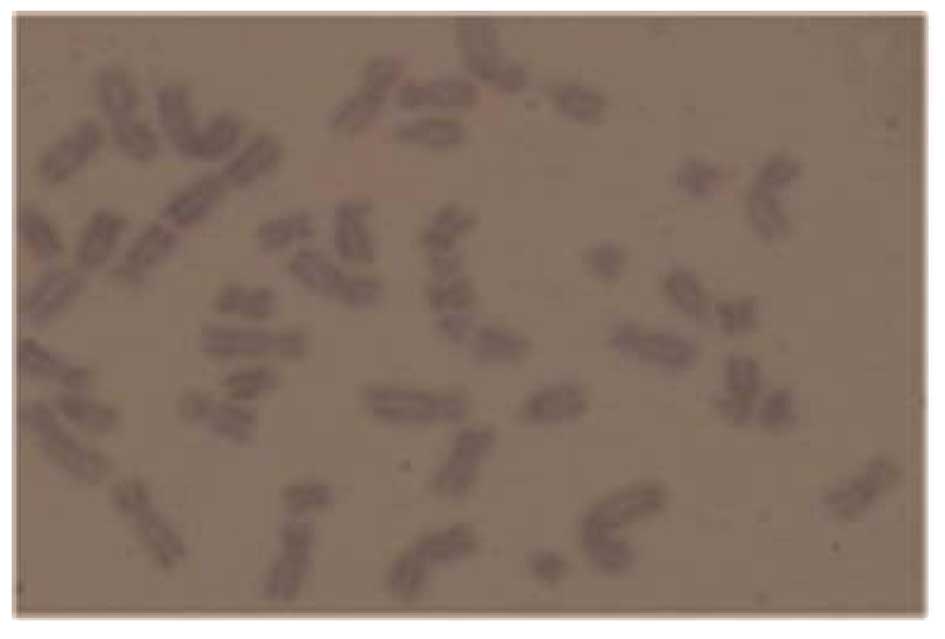|
1
|
Döhner H, Estey EH, Amadori S, et al:
European LeukemiaNet: Diagnosis and management of acute myeloid
leukemia in adults: recommendations from an international expert
panel, on behalf of the European LeukemiaNet. Blood. 115:453–474.
2010. View Article : Google Scholar
|
|
2
|
Dombret H, Raffoux E and Gardin C: New
insights in the management of elderly patients with acute myeloid
leukemia. Curr Opin Oncol. 21:589–593. 2009. View Article : Google Scholar : PubMed/NCBI
|
|
3
|
Lancet JE, Willman CL and Bennett JM:
Acute myelogenous leukemia and aging. Clinical interactions.
Hematol Oncol Clin North Am. 14:251–267. 2000. View Article : Google Scholar : PubMed/NCBI
|
|
4
|
Lin TL and Levy MY: Acute myeloid
leukemia: focus on novel therapeutic strategies. Clin Med Insights
Oncol. 6:205–217. 2012. View Article : Google Scholar : PubMed/NCBI
|
|
5
|
Ungewickell A and Medeiros BC: Novel
agents in acute myeloid leukemia. Int J Hematol. 96:178–185. 2012.
View Article : Google Scholar : PubMed/NCBI
|
|
6
|
Vardiman JW, Thiele J, Arber DA, et al:
The 2008 revision of the World Health Organization (WHO)
classification of myeloid neoplasms and acute leukemia: rationale
and important changes. Blood. 114:937–951. 2009. View Article : Google Scholar : PubMed/NCBI
|
|
7
|
Grimwade D, Walker H, Oliver F, et al: The
importance of diagnostic cytogenetics on outcome in AML: analysis
of 1,612 patients entered into the MRC AML 10 trial. The Medical
Research Council Adult and Children’s Leukaemia Working Parties.
Blood. 92:2322–2333. 1998.PubMed/NCBI
|
|
8
|
Löwenberg B: Diagnosis and prognosis in
acute myeloid leukemia - the art of distinction. N Engl J Med.
358:1960–1962. 2008. View Article : Google Scholar
|
|
9
|
Mohamedali A, Gäken J, Twine NA, et al:
Prevalence and prognostic significance of allelic imbalance by
single-nucleotide polymorphism analysis in low-risk myelodysplastic
syndromes. Blood. 110:3365–3373. 2007. View Article : Google Scholar : PubMed/NCBI
|
|
10
|
Tiu RV, Gondek LP, O’Keefe CL, et al: New
lesions detected by single nucleotide polymorphism array-based
chromosomal analysis have important clinical impact in acute
myeloid leukemia. J Clin Oncol. 27:5219–5226. 2009. View Article : Google Scholar : PubMed/NCBI
|
|
11
|
Bacher U, Haferlach T, Kern W, et al:
Conventional cytogenetics of myeloproliferative diseases other than
CML contribute valid information. Ann Hematol. 84:250–257. 2005.
View Article : Google Scholar : PubMed/NCBI
|
|
12
|
Haase D, Germing U, Schanz J, et al: New
insights into the prognostic impact of the karyotype in MDS and
correlation with subtypes: Evidence from a core dataset of 2124
patients. Blood. 110:4385–4395. 2007. View Article : Google Scholar : PubMed/NCBI
|
|
13
|
Kohlmann A, Grossmann V, Klein HU, et al:
Next-generation sequencing technology reveals a characteristic
pattern of molecular mutations in 72.8% of chronic myelomonocytic
leukemia by detecting frequent alterations in TET2, CBL, RAS, and
RUNX1. J Clin Oncol. 28:3858–3865. 2010. View Article : Google Scholar : PubMed/NCBI
|
|
14
|
Orazi A and Germing U: The
myelodysplastic/myeloproliferative neoplasms: myeloproliferative
diseases with dysplastic features. Leukemia. 22:1308–1319. 2008.
View Article : Google Scholar : PubMed/NCBI
|
|
15
|
Raghavan M, Smith LL, Lillington DM, et
al: Segmental uniparental disomy is a commonly acquired genetic
event in relapsed acute myeloid leukemia. Blood. 112:814–821. 2008.
View Article : Google Scholar : PubMed/NCBI
|
|
16
|
Gondek LP, Tiu R, O’Keefe CL, et al:
Chromosomal lesions and uniparental disomy detected by SNP arrays
in MDS, MDS/MPD, and MDS-derived AML. Blood. 111:1534–1542. 2008.
View Article : Google Scholar
|
|
17
|
Parikh SA and Tefferi A: Chronic
myelomonocytic leukemia: 2012 update on diagnosis, risk
stratification, and management. Am J Hematol. 87:610–619. 2012.
View Article : Google Scholar : PubMed/NCBI
|
|
18
|
Kantarjian H, Oki Y, Garcia-Manero G, et
al: Results of a randomized study of 3 schedules of low-dose
decitabine in higher-risk myelodysplastic syndrome and chronic
myelomonocytic leukemia. Blood. 109:52–57. 2007. View Article : Google Scholar
|
|
19
|
Steensma DP, Baer MR, Slack JL, et al:
Multicenter study of decitabine administered daily for 5 days every
4 weeks to adults with myelodysplastic syndromes: the alternative
dosing for outpatient treatment (ADOPT) trial. J Clin Oncol.
27:3842–3848. 2009. View Article : Google Scholar : PubMed/NCBI
|
|
20
|
de Lima M, Giralt S, Thall PF, et al:
Maintenance therapy with low-dose azacitidine after allogeneic
hematopoietic stem cell transplantation for recurrent acute
myelogenous leukemia or myelodysplastic syndrome: a dose and
schedule finding study. Cancer. 116:5420–5431. 2010. View Article : Google Scholar : PubMed/NCBI
|
|
21
|
Baer MR and Gojo I: Novel agents for the
treatment of acute myeloid leukemia in the older patient. J Natl
Compr Canc Netw. 9:331–335. 2011.PubMed/NCBI
|
|
22
|
Oki Y, Kondo Y, Yamamoto K, et al: Phase
I/II study of decitabine in patients with myelodysplastic syndrome:
a multi-center study in Japan. Cancer Sci. 103:1839–1847. 2012.
View Article : Google Scholar : PubMed/NCBI
|
|
23
|
Blum W, Garzon R, Klisovic RB, et al:
Clinical response and miR-29b predictive significance in older AML
patients treated with a 10-day schedule of decitabine. Proc Natl
Acad Sci USA. 107:7473–7478. 2010. View Article : Google Scholar : PubMed/NCBI
|
|
24
|
Yamada K, Furusawa S, Saito K, et al:
Concurrent use of granulocyte colony-stimulating factor with
low-dose cytosine arabinoside and aclarubicin for previously
treated acute myelogenous leukemia: a pilot study. Leukemia.
9:10–14. 1995.PubMed/NCBI
|
|
25
|
Saito K, Nakamura Y, Aoyagi M, et al:
Low-dose cytarabine and aclarubicin in combination with granulocyte
colony-stimulating factor (CAG regimen) for previously treated
patients with relapsed or primary resistant acute myelogenous
leukemia (AML) and previously untreated elderly patients with AML,
secondary AML, and refractory anemia with excess blasts in
transformation. Int J Hematol. 71:238–244. 2000.PubMed/NCBI
|
|
26
|
Suzushima H, Wada N, Yamasaki H, et al:
Low-dose cytarabine and aclarubicin in combination with granulocyte
colony-stimulating factor for elderly patients with previously
untreated acute myeloid leukemia. Leuk Res. 34:610–614. 2010.
View Article : Google Scholar
|













